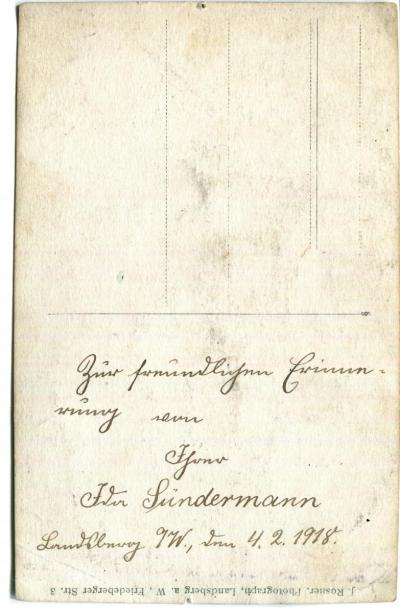Józef Rosner (1892–1971): The master of portraits

Heritage
Józef Rosner was born in Cieszyn in 1892 to a family blessed with many children. His mother Emma was German, his Father Ferdinand a Jew. His father, who managed a quarry, wanted his son to learn a solid profession and sent him as an apprentice to a locksmith in Moravska Ostrava (today Ostrava in the Czech Republic). However, young Józef decided that he wanted to be a photographer and gave up his apprenticeship after only a short time. His father was so incensed at his stubbornness that he denied him any further financial support so Józef had to earn his own living. He went to Vienna where he got a job with the court and chamber photographer Karl Pitzner. In 1908, he completed his apprenticeship examination with distinction and was now allowed to work more independently. There then followed a period of travel through a number of towns and photographic studios. In 1910, he settled in Germany. As an Austrian subject he was conscripted to the army during the First World War and fought on various fronts. Hardly anything is known about this time in his life. In 1917, before the end of the war, he married Elżbieta Berg in Landsberg (Gorzów Wielkopolski) . Their son Jerzy Marek was born in 1953.
Photographic studios in Landsberg and Chemnitz
After the First World War, Rosner stayed in Landsberg, where he ran a photographic studio in his name in Friedeberger Straße 3. In 1919, he gained the master craftsman certificate and then sought to extend his practical knowledge, which solidified his professional position. On the strength of this, he moved to Chemnitz in 1925 and opened a photographic studio in Bahnhofstrasse. He specialised in portraits.
Over time, Rosner developed his own method for lighting his models which he kept to consistently over the following decades, although initially the people sitting for the portraits were not keen at all. Rosner also kept the touch-up pen, with which the pictures could be “enhanced”, as a requisite because he was of the opinion that this type of retrospective work had nothing to do with “photographic truth”. His concern lay in reproducing the emotional and physical expression of the person portrayed such that their uniqueness became manifest. Rosner also dedicated himself to landscape photography a short time later. In doing so, he experimented with various photographic techniques and mainly created his works in the free hand method, and in rubber, pigment and bromine oil print.
“Rosner’s portraits – writes Lech Grabowski – are reluctantly sparing in the use of formal effects. They win you over with their authenticity. The landscapes speak a simple language too. The clarity of their composition and the simplicity of their motifs presumably stem from the author's conviction that the world of specific objects lies at the heart of a photograph. In Rosner’s landscapes, the materiality, the objectivity of the world portrayed is tangible. They are simple in their approach.” (Grabowski, p. 12)
From 1924, Rosner regularly took part in photographic exhibitions in Berlin, Hamburg, Leipzig, Frankfurt am Main, Jena, Essen and Cologne. However, his works were also shown in Denmark, France, Holland, Ireland, Japan, Sweden, Italy and in the USA. These frequent appearances attracted the attention of his colleagues in the field. More invitations to exhibitions followed. In 1927, he became a member of the Association of German Photographers, which appointed him to their jury jury in 1929. In the same year, he also submitted his work to the Third International Salon in Poznań.
Departure to Poland
When the Nazis seized power and pursued their race policies, Rosner was forced to leave for Poland in 1936. He settled in Kraków where he set up an art photography studio in the ul. Gertrudy 5 Street. He remained connected to the city for the rest of his life. The furnishing of this Kraków atelier was very modern because Rosner had brought a complete studio fitout with him to Poland. He is said to have been very courteous in his dealings with customers.
Prior to 1939, Rosner successfully took part in photography competitions in Warsaw , London, Paris and Rome.
The Second World War and the period of occupation
After the Germans occupied Kraków, the Rosners had to leave the villa in Gertrudy Street and were allocated an apartment a few streets further on in ul. Starowiślna 60 Street. During this move, parts of the studio fitout, including a 35 mm camera with lenses, were lost or were stolen. The employment office arranged a job for Rosner in one of the German photographic studios in the city. During this period, he made contact with the underground and gave them copies of photos that German soldiers had taken at the front.
In 1942, Rosner was arrested and served a year in the Gestapo prison in Montelupich Street in Kraków. The many interrogations had a permanent impact on his health. After his release, he worked in a photographic studio again.
Post-war years
After the war, Rosner opened a new photographic studio in ul. Starowiślna 22 Street. On behalf of the Komisja Badania Zbrodni Hitlerowskich (Commission for Coming to Terms with NS Crimes), he produced portraits of prisoners from Ausschwitz concentration camp by enlarging the existing pictorial records.
Rosner was also involved in the development of Polish photography. After resurrecting the Polskie Towarzystwo Fotograficzne (Polish Photographic Society), he was its President for a time. He passed on his knowledge in art photography courses and in lectures to amateur and professional photographers in Kraków and in other parts of Poland. His articles, such as “Świat Fotografii” (The world of photography) and “Fotografia” (Photography), were published in the photographic trade press. From 1950, Rosner was a member of the Związek Polskich Artystów Fotografików (Association of Polish Art Photographers), which made him an honorary member in 1956. His works could also be seen in Leipzig and Dresden in that year. He also took part in numerous exhibitions both at home and abroad.
In 1959, the City of Kraków awarded him its art prize for outstanding services to photography. Józef Rosner died in Kraków in 1971 after a serious illness and was buried in the Rakowicki cemetery.
Krzysztof Ruchniewicz, June 2018
Literature used:
Lech Grabowski, Wśród polskich mistrzów kamery (Among Polish masters of the camera), Warsaw 1964.
Henryk Hermanowicz, Józef Rosner (1892-1971), in: Polski Słownik Biograficzny, Vol. XXXII, Wrocław-Warsaw-Kraków 1989-1991, p. 110-111.

